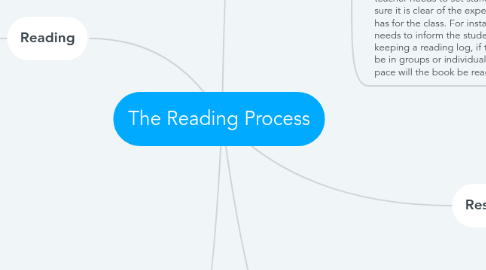The Reading Process
by Rebecca Middleton

1. Reading
1.1. It is very important to read aloud to students because it shows them an example of what good readers do. Sometimes reading aloud is more effective for students and helps to get them more involved. By keeping students involved by asking questions throughout your reading, reading aloud can be great for students.
1.2. Shard reading is also a good way to make sure students are staying on task with their reading. This is a way for the teacher to scaffold their reading while also holding them accountable to read also.
1.3. Guided reading is a good way to do group reading during class. It allows you to be able to focus on individual reading levels.
1.4. Partner is a really good alternate to independent reading because it helps student have a buddy to hold them accountable for their reading assignment, and they will also have a friend to discuss whatever they are reading with.
1.5. Independent reading allows students to work on their own reading skills independently. This also allows the teacher to walk around to check on students individually to make sure they're understanding the content.
2. Applying
2.1. Students can apply what they have read from their books by creating posters, slide shows, essays, performances, and may other projects. It is a good idea to let students have a sense of independency by letting them have options to choose from for class projects!
3. Prereading
3.1. It is important for your students to have some background knowledge before they begin to read. Teachers can help the students gain background knowledge on the book and its genre to make sure they are prepared.
3.2. It is important for the teacher to set a purpose for the book they are reading, and how they will apply it to the content they are learning.
3.3. Before the class begins reading the teacher needs to set standards and make sure it is clear of the expectations he/she has for the class. For instance the teacher needs to inform the students on if they are keeping a reading log, if the reading will be in groups or individual, and at what pace will the book be read.
4. Responding
4.1. Writing in reading logs is a good way for students to reflect on how their reading made them feel. As they write in the reading log they can look back on it to see the big picture of the book.
4.2. Discussions can be very crucial for students understanding of their reading. During group discussions students can hear about their fellow classmates opinion of the book which might help them understand the content better.
5. Exploring
5.1. If students seem to have trouble comprehending what they have read it will help them to do a reread of things they did not understand. This will help them catch things they may have missed in the reading before.
5.2. Close reading is used by teachers to scaffold students' thinking.
5.3. Creating things like a word wall that students add important words from their reading to will help them learn meanings of new words and expand their vocabulary.


